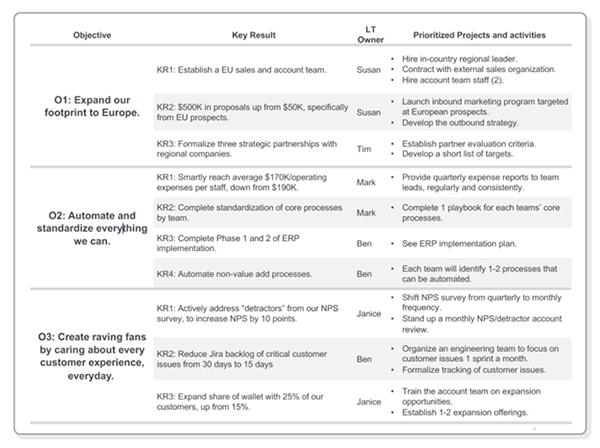Unlock #1: Objectives Need to Be Outcomes, Not Outputs
🤔 How are You Going to Be Better Off?
One of the most common pitfalls in using OKRs is creating objectives that are outputs instead of outcomes. And that starts with ensuring your objectives are broad and specific instead of task based. Larry and Erica deep-dive on this between 17:00-28:00 in the session. You can view the whole session with the chat transcript here! and you can also view the slide deck here!
❌ Traits of “Output” Objectives
- They sound like everyday tasks you already do
- Initiatives, projects, status reports, and routine deliverables.
- Activities we do that contribute toward achieving the outcome
- It does not guarantee success.
✅ Traits of “Outcome” Objectives
- A tangible or measurable business outcome.
- Measurable results are defined metrics or criteria.
- Demonstrate success objectively.
- They don’t change until we calibrate.
Pro Tip: Great objectives answer the questions, “how are we going to be better off as an organization?” and “how are we going to stretch ourselves?”
🚀Unlock #2: Great Objectives are Broad & Open
Larry and Erica discussed from 25:00-29:00 the need for objectives to be broad and open. Creating overly specific objectives that describe what will be done creates limiting objectives; meaning they are not open to all the possibilities.
6 Examples of Great Objectives from Slide 15 of the Deck
- Growth: Achieve record revenues while increasing market share
- Market Share: Expand our product offering globally
- Learning and growth: Build a great corporate culture and delight our employees
- Customer-centricity: Develop deep customer relationships to improve customer satisfaction
- Customer acquisition: Achieve record recurring revenues on subscription-based products & services
- Operational excellence: Modernize our technology infrastructure while decreasing our security exposure
Pro Tip: Avoid being overly specific in describing what will be done. It might seem counter-intuitive – but it limits the objective instead of opening all possibilities.
🎯 Unlock #3: Key Results Should Be Quantifiable OR Verifiable
💪 Key Results are “How” an Objective is Achieved
Key Results are the inputs to achieving your desired output – AKA the objective. And since we live in the Key Results in our day-to-day activities, this is where you create measurability in your OKR structure.
Key Results are designed to describe as a deliverable OR result. And we don’t just mean activities; we mean key results that need to outline quantitative results (#, $, %) OR the verifiable completion of a deliverable or project to help reach the broader objective.
Don’t miss the examples of the entire OKR stack from slide 20 of the deck!

Pro Tip: Start each KR with an action verb and continue the sentence by describing what will be delivered with evidence of completion. This evidence must be verifiable and accessible to relevant parties.
🙅♀️ Unlock #4: Say NO to Unguided OKR Development
That’s when OKRs start to mismatch, not align, and generally create a mess. The alternative is OKRs with guided frameworks and guardrails where OKRs cascade down from the top organizational strategy into the team and individual OKRs.
Pro Tip: Cascade OKRs from the top of the organization (Organization-wide) to Executives to Department Managers to Teams. Don’t try to start your OKR framework at the team level and plan upwards – it won’t create an alignment nor strategy, but just a task list instead.
🧐 Unlock #5: A Canvas to Deploy OKRs + 10 OKR Parameters to Follow
Erica and Larry covered 10 helpful OKR deployment parameters and a canvas to help outline your OKR cycles from 52:50-58:00 on slides 28-29 of the deck.
10 Universal OKR Deployment Parameters
- Levels: At what level will we set OKRs? Company, team, individual?
- OKR #: How many OKRs will we set?
- Scoring: How will we score OKRs? How will we update progress?
- Timeframe: How long is an OKR cycle?
- Types: What are the three types of key results?
- Publish: Where will we draft, publish, and track OKRs? What templates do we use?
- Performance: How will OKRs relate to performance reviews?
- KPIs vs KRs: How are OKRs different from KPIs?
- Alignment: How will we ensure OKRs are aligned?
- Bottom-Up: How will we ensure most OKRs originate “bottom-up”?
Pro Tip: Before you start creating your organization’s OKR framework, make sure you answer these 10 questions and use the canvas below! Here are two other helpful canvases for OKRs, including writing your OKRs and developing your OKR cycles.













